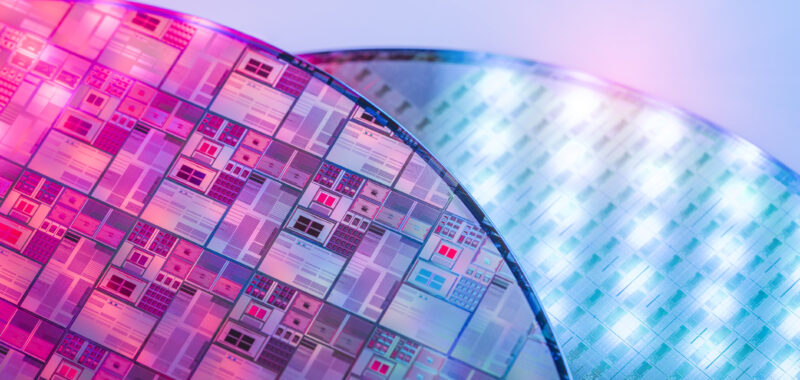ASML (ASML 3.23%) and Taiwan Semiconductor Manufacturing (TSM -2.46%), also known as TSMC, are both linchpins of the global semiconductor market. ASML is the world’s largest producer of photolithography systems, which optically etch circuit patterns onto silicon wafers. TSMC, which uses ASML’s systems to manufacture its chips, is the world’s largest and most technologically advanced contract chipmaker.
ASML is also the only producer of extreme ultraviolet (EUV) lithography systems, which are used to produce the world’s smallest, densest, and most power-efficient chips. ASML’s largest customer, TSMC, uses those EUV systems to manufacture top-tier chips for fabless chipmakers like Apple, AMD, Nvidia, and Qualcomm.

Image source: Getty Images.
So without ASML, the world’s leading foundries — including TSMC, Samsung, and Intel — couldn’t manufacture their most advanced chips. And without those foundries, the global production of semiconductors would grind to a halt.
That’s why many investors see ASML and TSMC as the bellwethers of the sector. But over the past 12 months, ASML’s stock only rose about 10%, as TSMC’s stock more than doubled. Let’s see why TSMC outperformed ASML by such a wide margin — and if it will continue to generate bigger gains for the foreseeable future.
ASML expects a slower recovery
ASML’s revenue rose 14% in 2022 and 30% in 2023. A lot of that growth was driven by the rapid expansion of the artificial intelligence (AI) market and the “process race” between the top foundries to manufacture smaller and more advanced chips.
But in 2024, it expects it revenue growth to flatline as it laps the AI market’s growth spurt, copes with tighter export curbs for Chinese chipmakers, and gradually transitions from its older “low-NA” EUV systems to its newer “high-NA” EUV systems.
ASML originally expected its revenue to rise 43% in 2025 as it ramped up its shipments of high-NA EUV systems, which cost more than twice as much ($380 million) as its low-NA EUV systems ($180 million), but are required to manufacture even smaller chips. But in its recent third-quarter earnings report, ASML reduced that revenue outlook to just 7%-25% growth. Analysts still expect its revenue and earnings to rise 25% and 44%, respectively, in 2025.
ASML mainly blamed that slower-than-expected recovery on the industry’s conservative adoption of its high-NA EUV systems. TSMC and Samsung are still focused on pushing their low-NA EUV systems to the limit for their existing chipmaking processes, and both companies only recently ordered their first high-NA EUV systems. Intel ordered its high-NA EUV systems earlier, but those plans could shift if it finally spins off or sells its capital-intensive foundry business.
Many chipmakers are also focused on producing more advanced AI chips at the same nodes, instead of aggressively shrinking them down with more expensive lithography systems. The export restrictions against ASML’s sales of advanced lithography systems to Chinese chipmakers has been exacerbating that pressure.
TSMC faces fewer near-term headwinds
TSMC’s revenue rose 34% in 2022, but declined 9% in 2023. That deceleration was caused by the PC market’s slowdown, the end of the 5G upgrade cycle for smartphones, and macro headwinds for the data center market.
But in its recent third-quarter earnings report, TSMC raised its full-year revenue outlook from the “mid-20s” growth to “nearly 30%” growth. Analysts had expected its revenue and earnings to rise 26% and 27%, respectively, for the full year.
TSMC expects that robust growth to be driven by the expansion of the AI market and the stabilization of the PC and smartphone markets. In its latest quarter, the company generated 51% of its revenue from the high-performance computing (HPC) market, which includes Nvidia’s AI-oriented data center GPUs and AMD’s latest chips. Another 34% came from the smartphone market, which includes mobile chipmakers like Qualcomm and Apple.
More than half of TSMC’s revenues came from its smallest 5nm and 3nm nodes during the quarter, but it will reportedly stick with its existing low-NA EUV systems for its upcoming 2nm and 1.6nm nodes. That might save TSMC a lot of money, but it could spell trouble for ASML. For 2025, analysts expect TSMC’s revenue and earnings to grow 24% and 27%, respectively.
TSMC produces its most advanced chips in Taiwan, and it only manufactures its older and larger chips in China and other countries. That diversification naturally insulates it from the tighter export curbs against China, even if some of its fabless customers are barred from shipping their most advanced chips to Chinese companies.
The better buy: TSMC
ASML and TSMC both look reasonably valued at about 23 times forward earnings. ASML is still a solid long-term investment in the semiconductor market, but it’s growing slower than TSMC, it’s more exposed to the export curbs against China, and it isn’t as broadly diversified. That’s why I believe TSMC will remain a stronger chip stock than ASML for the foreseeable future.
Leo Sun has positions in ASML and Apple. The Motley Fool has positions in and recommends ASML, Advanced Micro Devices, Apple, Nvidia, Qualcomm, and Taiwan Semiconductor Manufacturing. The Motley Fool recommends Intel and recommends the following options: short November 2024 $24 calls on Intel. The Motley Fool has a disclosure policy.

